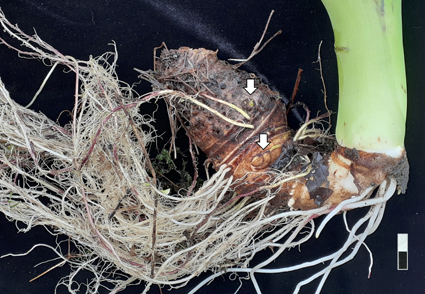Abstract
Colocasia spongifolia sp. nov. (Araceae) is a large herb in forest edges on mountain slopes in southern China and central Vietnam. The plant is remarkable for its distinct vegetative morphology, while floral morphology places it as a close wild relative of C. esculenta (taro), among other closely-related species. The name given here reflects a thick, rubbery, spongy leaf blade unlike the blades in other Colocasia species known to us. The blade has exceptionally large spongy mesophyll cavities that are visible to the naked eye. Vegetative reproduction appears to be limited to direct (though shy) sprouting of lateral buds to form new erect stems, without production of side-tubers or stolons. In contrast to other Colocasia species, dense spreading colonies (clumps or patches) were not seen.
References
Beck, H.E., Zimmermann, N.E., McVicar, T.R., Vergopolan, N., Berg, A. & Wood, E.F. (2018) Present and future Köppen-Geiger climate classification maps at 1-km resolution. Nature Scientific Data 5: 180214. https://doi.org/10.1038/sdata.2018.214
Boyce, P.C. & Croat, T.B. (2011 onwards) The Überlist of Araceae, Totals for Published and Estimated Number of Species in Aroid Genera. Available from: http://www.aroid.org/genera/20201008Uberlist.pdf (accessed 10 November 2021)
Boyce, P.C., Sookchaloem, D., Hetterscheid, W.L.A., Gusman, G., Jacobsen, N., Idei, T. & Nguyen, V.D. (2012) Araceae. Flora of Thailand 11: 101–321.
Cai, X.-Z., Long, C.-L. & Liu, K.-M. (2006) Colocasia yunnanensis (Araceae), a new species from Yunnan, China. Annales Botanici Fennici 43: 139–142.
Chai?r, H., Traore, R.E., Duval, M.F., Rivallan, R., Mukherjee, A., Aboagye, L.M., Van Rensburg, W.J., Andrianavalona, V., Pinheiro de Carvalho, M.A.A., Saborio, F., Sri Prana, M., Komolong, B., Lawac, F. & Lebot, V. (2016) Genetic diversification and dispersal of taro (Colocasia esculenta (L.) Schott). PLoS One 11: e0157712. https://doi.org/10.1371/journal.pone.0157712
Climate-Data.org (2021) Hue, Vietnam & Mengla, China. Available from: https://en.climate-data.org/asia (accessed 1 March 2021)
Gogoi, R. & Borah, S. (2013) Two new species and a new record for Colocasia (Araceae: Colocasieae) from Arunachal Pradesh, Northeast India. Gardens’ Bulletin Singapore 65: 27–37.
Gogoi, R., Borah, S. & Sarma, J. (2019) Taxonomic identity and lectotypification of Colocasia mannii (Araceae), a little known species from Northeast India. Nelumbo 61: 131–134. https://doi.org/10.20324/nelumbo/v61/2019/146168
Hay, A. (1996) A new Bornean species of Colocasia Schott (Araceae-Colocasieae), with a synopsis of the genus in Malesia and Australia. Sandakania 7: 31–48.
Hayata, B. (1919) Colocasia formosana. Icones plantarum formosanarum nec non et contributiones ad floram formosanam 8: 133–134, f. 60.
Hooker, J.D. (1893) Aroideae. The Flora of British India, Vol. VI (Part XIX). L. Reeve & Co., London, pp. 490–556.
Li, H. & Boyce, P.C. (2010) Colocasia. In: Wu, Z.Y., Raven, P.H. & Hong, D.Y. (Eds.) Flora of China. Vol. 23 (Acoraceae through Cyperaceae). Science Press & Missouri Botanical Garden Press, Beijing & St. Louis, pp. 73–75.
Li, H. & Long, C.-L. (1999) A new species of Colocasia (Araceae) from Mts. Gaoligong, China. Feddes Repertorium 110: 423–424. https://doi.org/10.1002/fedr.19991100513
Linnaeus, C. (1753) Species Plantarum, Vol. 2. Stockholm.
Long, C.L. & Li, H. (2008) Colocasia gongii (Araceae), a new species from Yunnan, China. Feddes Repertorium 111: 559–560. https://doi.org/10.1002/fedr.20001110721
Long, C.-L. & Liu, K.-M. (2001) Colocasia lihengiae (Araceae: Colocasiae), a new species from Yunnan, China. Botanical Bulletin of the Academica Sinica 42: 313–317.
Matthews, P.J. (1991) A possible tropical wildtype taro: Colocasia esculenta var. aquatilis. Indo-Pacific Prehistory Association Bulletin 11: 69–81. https://doi.org/10.7152/bippa.v11i0.11374
Matthews, P.J. (2014) On the Trail of Taro: An Exploration of Natural and Cultural History. National Museum of Ethnology, Osaka, 429 pp.
Matthews, P.J. & Ghanem, M.E. (2021) Perception gaps that may explain the status of taro (Colocasia esculenta) as an “orphan crop”. Plants, People, Planet 3: 99–112. https://doi.org/10.1002/ppp3.10155
Matthews, P.J., Nguyen, V.D., Tandang, D., Agoo, E.M. & Madulid, D.A. (2015) Taxonomy and ethnobotany of Colocasia esculenta and C. formosana (Araceae): implications for evolution, natural range, and domestication of taro. Aroideana Supplement, 38E: 153–176.
Mayo, S.J., Bogner, J. & Boyce, P.C. (1997) The Genera of Araceae. Royal Botanic Gardens, Kew, 370 pp. https://doi.org/10.1007/978-3-662-03531-3_7
Nguyen, V.D. (2005a) Araceae. In: Ban, N.T. (Ed.) Checklist of Plant Species in Vietnam. Agricultural Publishing House, Hanoi, pp. 871–897.
Nguyen, V.D. (2005b) A new species of Colocasia (Araceae) contributed to the flora of Vietnam. VNU Journal of Science, Natural Sciences and Technology 21: 54–56.
Nguyen, V.D. (2017) Ho Ray - Araceae Juss. Flora of Vietnam 16. Publishing House for Science and Technology, Hanoi, 458 pp.
Nguyen, V.D., Matthews, P.J., Ahmed, I. & Nguyen, C.S. (2016) Colocasia yunnanensis (Araceae), a new record for the flora of Vietnam. The Journal of Japanese Botany 91: 223–229.
Orchard, A.E. (2006) Infra-specific variation in Colocasia esculenta (L.) Schott (Araceae). Australian Systematic Botany Society Newsletter 129: 2–5.
Schott, H. (1832) Aroidearum synopsis. In: Schott, H. & Endlicher, S. (Eds.) Meletemata Botanica. Gerold, Vienna, pp. 15–32.
Yin, J.-T., Li, H. & Xu, Z.-F. (2004) Colocasia menglaensis (Araceae). a new species from southern Yunnan, China. Annales Botanici Fennici 41: 223–226.
Zhou, S.-S., Quan, R-C., Li, R., Liu, Q. & Yin, J.-T. (2020) Colocasia kachinensis, a new species of Araceae from Myanmar. Phytokeys 138: 41–47. https://doi.org/10.3897/phytokeys.138.36769
Zhu, D., Eyzaguirre, P.B., Zhou, M., Sears, L. & Liu, G. (Eds.) (2000) Ethnobotany and genetic diversity of Asian taro: focus on China. IPGRI Office for East Asia, Beijing, 99 pp.


